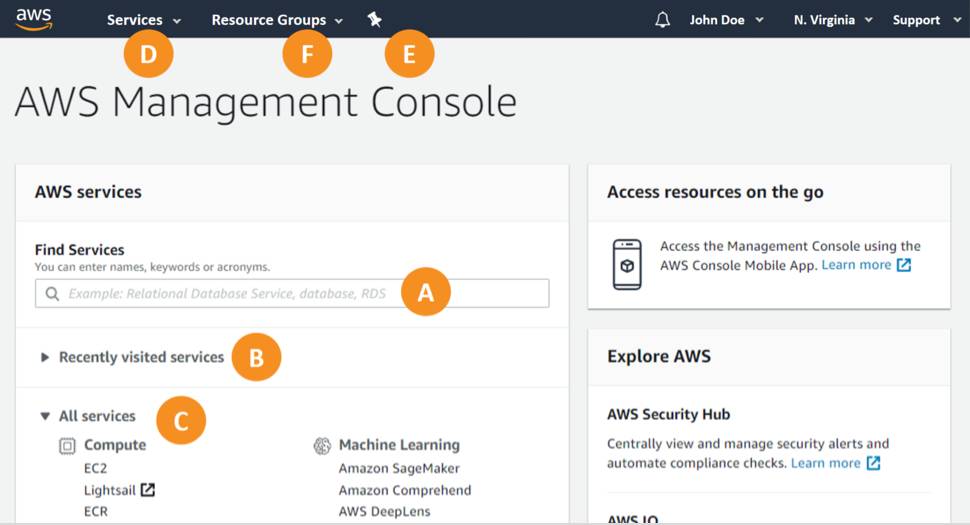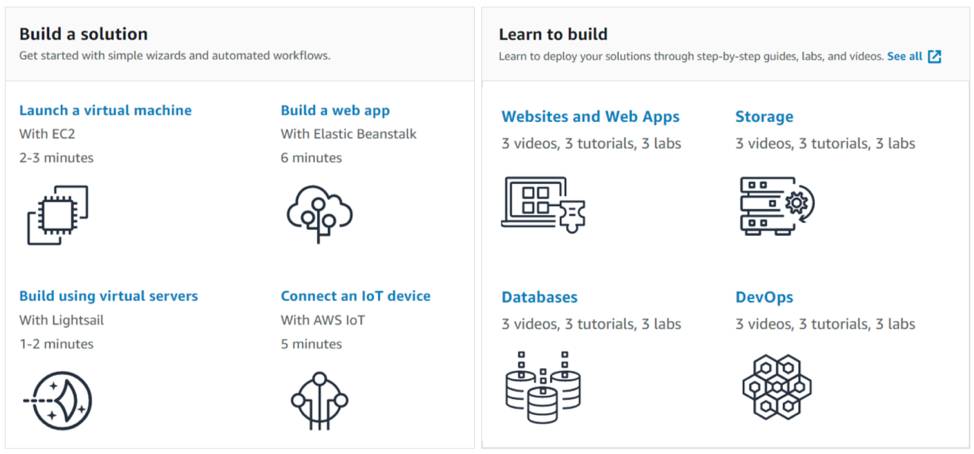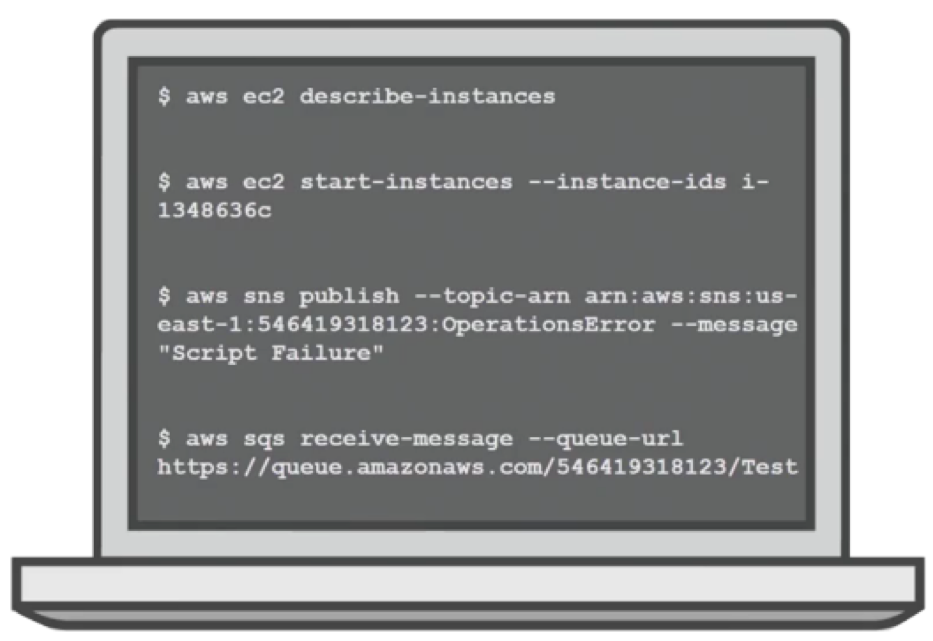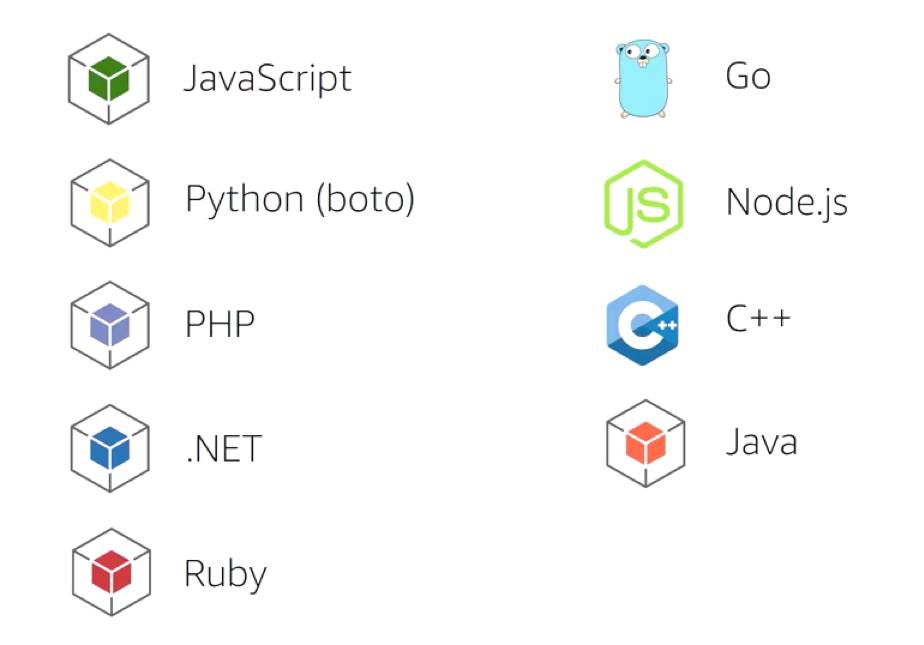Use the AWS Management Interfaces
Learning Objectives
After completing this unit, you’ll be able to:
- Describe the options for accessing and interacting with AWS resources.
This unit introduces you to the convenient options for accessing and using AWS resources.
AWS Management Tools
There are three tools that you can use to create and manage AWS resources.
- The AWS Management Console.
- The AWS Command Line Interface (AWS CLI).
- The AWS Software Development Kits (SDKs).
Each option is built upon a common interface, or API, that serves as the foundation for AWS. So you can use these tools interchangeably.
AWS Management Console
The AWS Management Console is a graphical interface used to interact with AWS services and features. You can manage all aspects of AWS services, as well as your AWS account, including monitoring your monthly spending, managing security credentials, and setting up new users.
 Find Services in the Console
Find Services in the Console
There are several ways to find and open services that you need. On the homepage you can (A) search for what you need, (B) select recently visited services, or (C) expand the All services section to browse through all of the AWS services. The Services option (D) is always displayed in the top navigation bar, allowing you to search for what you need at any time, list services by groups, or arrange alphabetically.
Personalize Your AWS Experience
You can personalize your experience in the console by creating shortcuts to the services that you visit the most often. The pin icon (E) allows you to drag and drop service links right onto the toolbar. You can use Resource Groups (F) to streamline your use of the console.
You can create a resource group for each application, service, and collection of related resources you frequently use. This allows you to quickly navigate to each saved resource group using the AWS menu in the top left corner of the screen. Resource groups are specific to identities, so each user in your account can create unique resource groups for their own frequently-accessed resources and their common tasks. You can also share resource group definitions with others in the same account using a URL.
With Resource Groups, you can view collections of resources that share common tags. The Tag Editor allows you to easily manage tags for resource types that support tags and apply tag keys and values to multiple resources at one time. The Tag Editor supports global tag searching and bulk editing, so you can find all resources with a particular tag, or make a tag change across multiple resources with just a few clicks.
Learn More About AWS
The console homepage also features resources to help you learn about the services and features AWS has to offer and get you started building your solutions faster.
- The Build a solution section features automated wizards and workflows that can help you create the resources that you need for your solution.
- The Learn to build section includes learning resources organized by solution type and use case. Resources include tutorials, videos, self-paced labs, project guides, and course documentation.

Manage AWS Resources from Your Mobile Device
There’s even an app that you can use with iOS or Android platforms, so that you can view your existing resources and alarms, and perform tasks at your convenience.
AWS CLI

The AWS Command Line Interface (AWS CLI) is an open-source tool that lets you interact with the AWS services without having to do a lot of configuration. With the AWS CLI, you use command in your terminal program, like Linux shells, Windows command line, and a remote terminal such as PuTTY or SSH.
The AWS CLI provides direct access to the public APIs of AWS services. You can explore a service’s capabilities with the AWS CLI, and develop shell scripts to manage your resources. Or you can take what you learn to develop programs in other languages by using the AWS SDKs.
AWS SDKs
The AWS SDK and its supporting interfaces enable you to access AWS using a variety of popular programming languages. This makes it easy to use AWS in your existing applications and enables creating applications to deploy and monitor complex systems entirely through code. These language-specific SDKs contain APIs that allow you to easily incorporate the connectivity and functionality of the wider range of AWS Cloud services into your code without the difficulty of having to code the functions yourself.

AWS provides extensive resources for these SDKs, including getting started guides, developer guides, API references, as well as community forums and blogs.
Wrap-Up
This module was the first step in understanding the essentials of the AWS Cloud. Now that you know the basics, we encourage you to keep learning and expand your knowledge about the AWS Cloud and services.